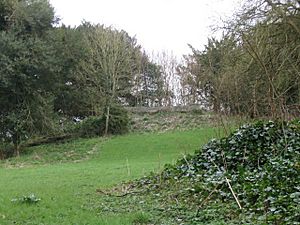Ashley Castle facts for kids
Ashley Castle was once a strong fortress in the small village of Ashley, Test Valley, Hampshire. Today, only its remains can be seen. It has a long and interesting history, stretching back to ancient times.
Contents
Building the Castle
The castle, sometimes called Gains Castle, was first built in 1138. It was placed on the site of an even older Iron Age fort. This spot was very important because it was on high ground. It also had a well and was close to a Roman road.
The person who built it was Henry of Blois. He was a powerful man and the Bishop of Winchester. He was also the grandson of William the Conqueror and the younger brother of King Stephen. Henry de Blois built many castles and was one of the most important people in England during his time.
Tearing it Down
Ashley Castle was built during a time called the Anarchy. This was a long period of civil war in England. King Stephen and Empress Matilda were fighting for the throne. The war ended in 1154 when Matilda's son, Henry II of England, became king.
Soon after, in 1155, Ashley Castle was "slighted." This means it was partly torn down on purpose. Many other castles built by Henry of Blois were also slighted. King Henry II did this to show his power and control. He wanted to destroy castles that had been built without royal permission during the war.
Building it Again
Even after being torn down, Ashley Castle got a second chance. About 50 years later, during the time of King John, the castle was rebuilt. A new owner, William Briwere, probably rebuilt it with stone.
William Briwere was a close advisor to King John. He was also involved in the signing of the Magna Carta in 1215. King John gave Briwere special permission to build defenses for several castles in 1200. This was a rare privilege back then. Briwere chose to fortify Ashley Castle.
A Royal Forest Headquarters
King John often visited Ashley Castle. He likely used it as a base for hunting in the nearby royal forest of West Bere. The castle also served as an official office. Royal letters from this time were sometimes written from "Ashley."
Ashley Castle was the main office for the royal forest of West Bere. This forest stretched between two rivers. The chief officer for the forest was called the Warden. The Warden lived at Ashley Castle when he was there. He made sure that "forest law" was followed. This law protected the king's hunting grounds.
Later Owners
In 1312, the castle passed to the Despensers family. This family was connected to another unpopular king, Edward II of England. One family member, Hugh Despenser the Younger, was a close friend of King Edward II. He was later found guilty of treason and executed.
Even after this, Ashley Castle was returned to the Despensers. But history repeated itself. In 1400, Thomas Despenser, 1st Earl of Gloucester, was also executed for opposing Henry IV of England. After this, the castle became a home for the Bishops of Winchester until the mid-1400s. It was finally abandoned around the 1600s. Its stones were taken and used for other buildings.
What it Looked Like
When it was first built, Ashley Castle was an earth and timber "ringwork." This means it had a round bank of earth surrounded by a deep ditch. This design likely used the older Iron Age defenses. Inside the ringwork, there was probably a Great Hall or a tower.
West of the ringwork was a second area called a "bailey." This was a rectangular court with more buildings. Both the ringwork and the bailey had wooden fences on top of their banks. The local church, St Mary's Church, Ashley, was also in the bailey. It was built around the same time as the castle and still stands today.
Today, you can still see parts of the ditch and the earth banks of the castle. The site is on private land and is a protected monument.
See Also


